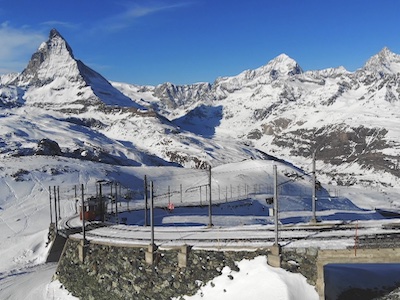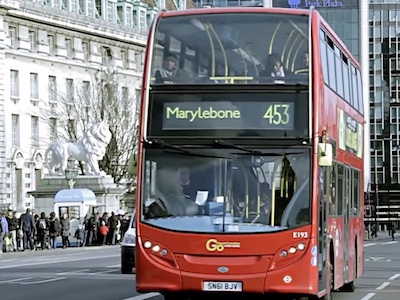In this guide, we will use the "diversity" strategy. It selects frames which are visually different from those observed before. This is useful to collect novel scenarios on your edge device.
We showcase it on the same images we used in 03 Similarity Search. This time, we expect only one image selected from each location.




Project Setup
Code for this tutorial is provided in examples/04_diversity_selection directory. Before starting this tutorial, copy the model file to examples/lightly_model.tar and verify that your project layout is as follows:
lightly_edge_sdk_cpp
├── ...
└── examples
├── ...
├── 04_diversity_selection
│ ├── CMakeLists.txt
│ ├── images
│ │ ├── london1.jpg
│ │ ├── london2.jpg
│ │ ├── matterhorn1.jpg
│ │ └── matterhorn2.jpg
│ ├── main.cpp
│ └── stb_image.h
└── lightly_model.tar
Build and Run a Complete Example
See below the content of the main.cpp file. We will first run the example, and explain it right after.
3#define STB_IMAGE_IMPLEMENTATION
5#include "lightly_edge_sdk.h"
9Frame load_image(std::string image_path) {
10 std::cout <<
"Loading image: " << image_path << std::endl;
11 int width, height, channels;
12 unsigned char *data = stbi_load(image_path.c_str(), &width, &height, &channels, 0);
13 if (data ==
nullptr) {
14 throw std::runtime_error(
"Failed to load image.");
17 return Frame(width, height, data);
22 std::cout <<
"Initializing LightlyEdge..." << std::endl << std::endl;
23 lightly_edge_sdk::LightlyEdgeConfig config = lightly_edge_sdk::default_config();
25 LightlyEdge::new_from_tar(
"../lightly_model.tar", config);
28 float threshold = 0.1;
32 std::vector<std::string> image_paths = {
33 "images/matterhorn1.jpg",
34 "images/matterhorn2.jpg",
38 for (
const auto &path : image_paths) {
40 Frame frame = load_image(path);
43 std::vector<float> image_embedding = lightly_edge.
embed_frame(frame);
48 if (diversity_select_info.should_select) {
53 std::cout <<
" should_select: " << diversity_select_info.should_select << std::endl;
54 std::cout <<
" min_distance: " << diversity_select_info.min_distance << std::endl << std::endl;
60 std::cout <<
"Program successfully finished." << std::endl;
LightlyEdge.
Definition lightly_edge_sdk.h:119
auto register_diversity_strategy(float min_distance) const -> void
Register a diversity strategy.
Definition lightly_edge_sdk.h:471
void insert_into_embedding_database(const std::vector< float > &embedding) const
Insert an embedding into the database.
Definition lightly_edge_sdk.h:340
auto should_select(const std::vector< float > &embedding, const std::vector< ObjectDetection > &detections) const -> SelectInfo
Check if a frame should be selected.
Definition lightly_edge_sdk.h:1001
auto embed_frame(const Frame &frame) const -> std::vector< float >
Embed an RGB image.
Definition lightly_edge_sdk.h:232
Namespace with core LightlyEdge SDK functionality.
Definition lightly_edge_error.h:15
Holds information whether a frame should be selected or not.
Definition lightly_edge_rs_bindings.h:42
Frame data for LightlyEdge.
Definition lightly_edge_sdk.h:25
void * rgbImageData_
Pointer to the RGB image data.
Definition lightly_edge_sdk.h:42
Selection information about a processed frame.
Definition lightly_edge_sdk.h:84
std::vector< DiversitySelectInfo > diversity
The diversity selection info for each diversity strategy in the order of registration.
Definition lightly_edge_sdk.h:89
Build and run:
cd 04_diversity_selection
cmake -B build
cmake --build build
./build/main
.\build\[build_type]\main.exe
The output should be similar to the following, the distances might slightly differ on your machine architecture:
Initializing LightlyEdge...
Loading image: images/matterhorn1.jpg
should_select: 1
min_distance: 1
Loading image: images/matterhorn2.jpg
should_select: 0
min_distance: 0.0369358
Loading image: images/london1.jpg
should_select: 1
min_distance: 0.24345
Loading image: images/london2.jpg
should_select: 0
min_distance: 0.084776
Program successfully finished.
We see that only the first Matterhorn image and the first London image are selected, which is what we expected. We explain the rest of the output below.
- Note
- In this example we use the model version
lightly_model_14.tar. You might need to adjust the thresholds in this tutorial if your model version differs.
Diversity Selection
There are several steps needed to set up diversity selection. Note that in a real application the exceptions should be handled in a try-catch block. For clarity, we annotate the return types.
Image loading is identical to the previous 03 Similarity Search guide. What differs is how LightlyEdge is set up and how each image is processed. Let's start with the initialization code at the beginning of the main function:
std::cout << "Initializing LightlyEdge..." << std::endl << std::endl;
LightlyEdge lightly_edge = LightlyEdge::new_from_tar(
"lightly_model.tar");
float threshold = 0.1;
LightlyEdge is first initialized from a TAR archive. Recall that we can register any number of selection strategies with LightlyEdge. We register a single diversity strategy with lightly_edge_sdk::LightlyEdge::register_diversity_strategy.
The function accepts a single argument: min_distance. An observed image is selected only if it is further than min_distance from all previously observed images in the embedding space. The distances are based on cosine similarity and range from 0 (closest) to 1 (furthest).
Next, images are processed in the loop in the main function:
for (const auto &path : image_paths) {
Frame frame = load_image(path);
std::vector<float> image_embedding = lightly_edge.
embed_frame(frame);
if (diversity_select_info.should_select) {
}
std::cout << " should_select: " << diversity_select_info.should_select << std::endl;
std::cout << " min_distance: " << diversity_select_info.min_distance << std::endl << std::endl;
}
The code first embeds the image and calls lightly_edge_sdk::LightlyEdge::should_select which returns lightly_edge_sdk::SelectInfo. The structure contains the decision of each registered strategy whether a frame should be selected.
We load the decision for the single strategy we registered into diversity_select_info. LightlyEdge does not by default remember the images that are observed, we have to manually insert the embeddings into the embedding database by calling lightly_edge_sdk::LightlyEdge::insert_into_embedding_database.
Finally, we print whether the image was selected and its distance to the closest embedding in the database.
How To Choose Diversity Parameters
Consecutive images in a video stream are often very similar. Set the min_distance parameter to a small value, in the range 0.005 to 0.1. The value should be adjusted based on the desired level of diversity in the selected images. A higher value selects more diverse images, leading to a lower selection rate.
With lightly_model_14.tar model, a value in the range 0.008 to 0.015 leads to a selection rate of about 0.5 fps. This is approximate, low values should be used if there is low variation in input video, e.g. a car moving slowly during a rush hour or driving in a rural area in the night.
Next Steps
Next, we introduce Adaptive Diversity which allows you to select diverse images without specifying thresholds.



